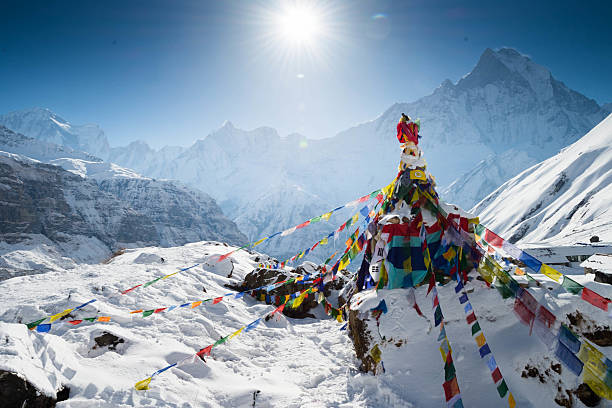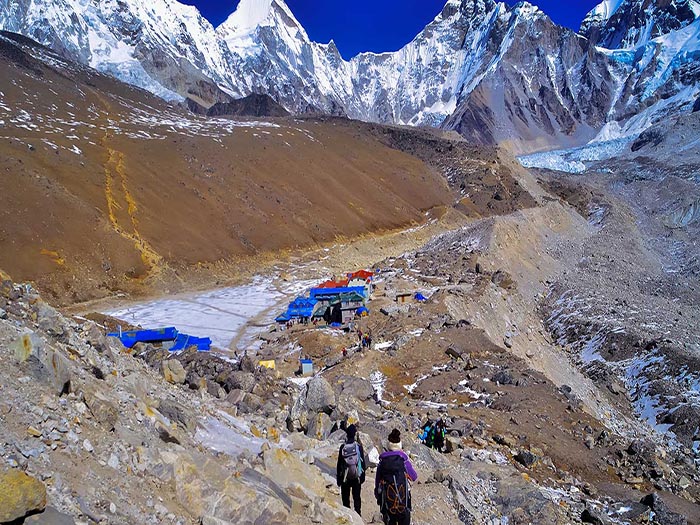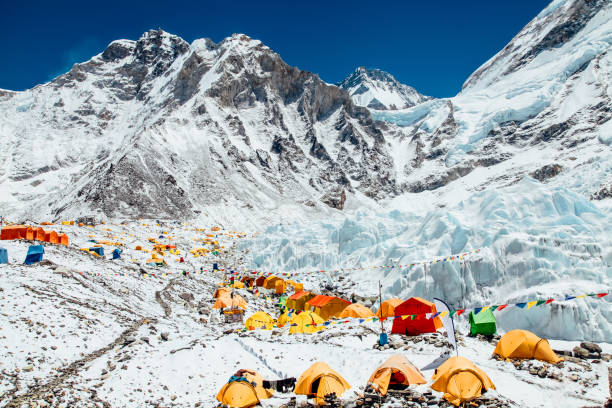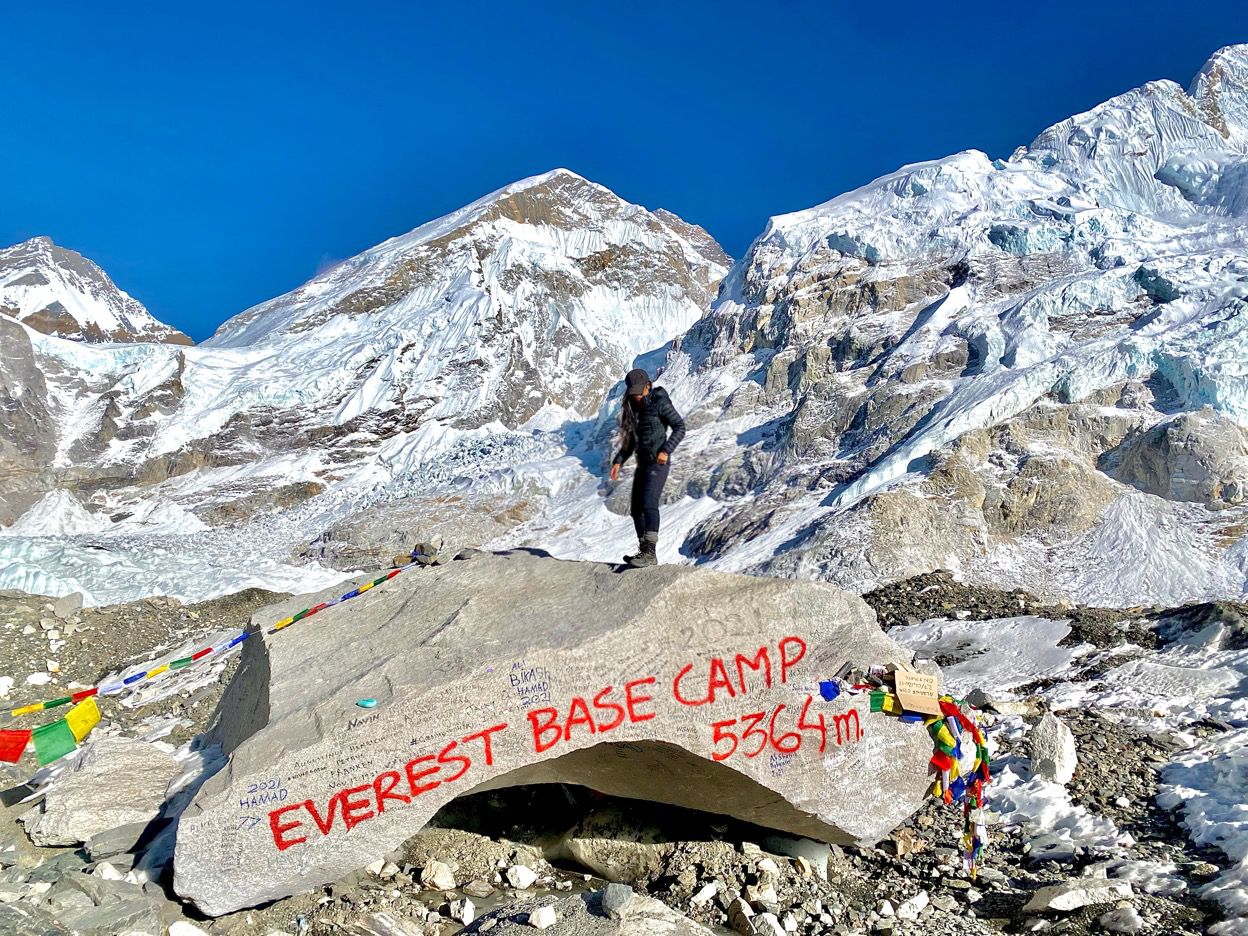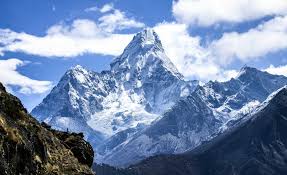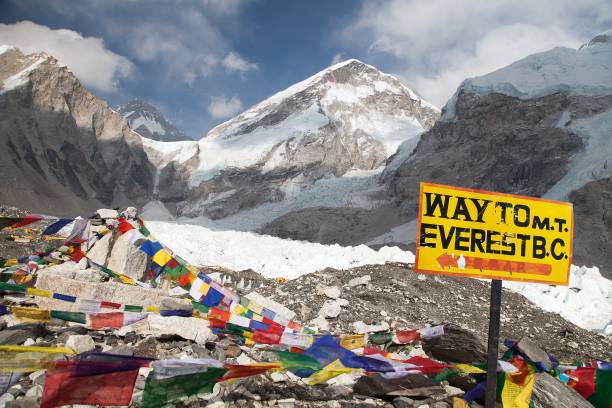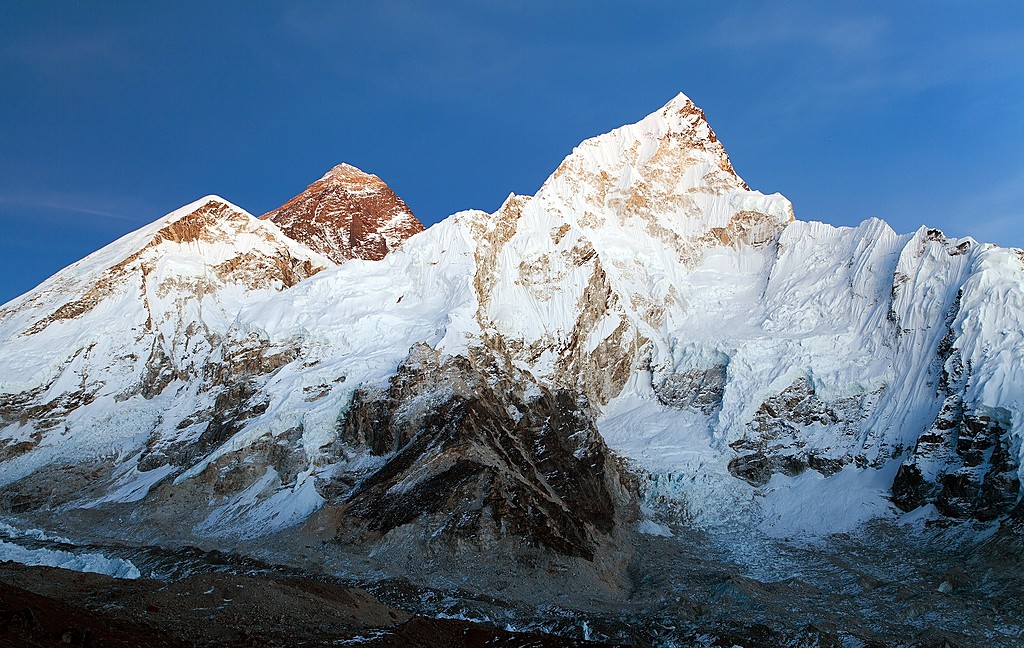"Every mountain top is within reach if you just keep climbing." - Barry Finlay
About Trip
Everest base camp trek or shortly Everest Trek has been the iconic choice of trekkers in himalayan region of Nepal, with the time of 1953. Today an ideal world, of us would like to stand at the summit of the earth, 8,848 meters above sea level on Mt. Everest - the highest peak. Most of us, realistically, will not be able to do this! However, if you are physically fit and mentally determined, you can reach Lukla to Everest Base Camp and can collect unforgettable memories. And, believe us, the views of Everest from Kalapatthar are the best you can get without spending weeks of hiking up to the peak from Lukla.
How to reach EBC?
The magnificient route from the Tenzing Hillary Airport (Lukla) to Everest Base Camp touches you to other harmonic settlements such as Lukla, Namche, Tengboche, Khumjung Valley, Pangboche, Dingboche, Lobuche, Gorakshep and Kalapathhar respectively in the sagarmatha national park. Where the paths are decorated with Buddhist monuments such as stupas, monastries, mani wheel, pray flags and yaks passing by.
About sherpaland
On the way passing by the magnificient mountain, climbers people from Sherpa tribe-one of the Nepal's Tibeten ethnic group are always ready to heartly welcome you in their community. The major old village like khumjung village, Pangboche village are the major old and gold villages of sherpa people in the route where khumjung monastries has conserved Yeti's sculpture as evidence of Yet's existance. Their smiley face and helpful behaviour makes your trip unknowingly greatful and comfortable. They are always open to share their cultural and traditional lifestyle for visitors.
Major Peaks of attraction in Everest region
- Mt Everest (8,848m/29, 028ft)
- Lhotse (8,516 m/24,940 ft)
- Nuptse (7,855m/25,772 ft)
- Makalu (8,463m/27758ft)
- Pumori (7,161m/23488ft)
- Tharmarsarku (6,623m/21723ft)
- Mt. Amadablam (6,812m/22349.08ft)
- And many more…
Besides the breath taking views and epic landscape safety mesures are one of the essential factor that visitors have to consider in priority. So following the goverment rules and regulations, communities norms and values, social and cultural respects and proper preparation with arrangements of tea houses ,essential gears, proper medication for altitude sickness and following to experties guide and porters for going to your trip is very compulsory.
Hopefully, you may have read through our blog sections on and have acquired all of the information you need, to help you determine when you want to take on this journey, what to pack on the EBC trek, and some of the major attraction on EBC Trek.
The type of lodging is a twin-share arrangement. With a nominal fee, access to hot showers, wifi, and power outlets is available. Where else can you have incredible views of the Himalayan mountains from your window, despite the apartments not being luxurious? Fresh Himalayan cuisine is served in the teahouses along the trail. Where else can you drink a steaming hot DalBhat while taking in the breathtaking splendor of the Khumbu Valley? Good physical condition is necessary. However, we'll make sure you're properly acclimated to the altitude, on the trek, we advise you to stay well-hydrated and limit your alcohol consumption.
If you want to see Mount Everest but don't have more than a week to hike then you can aslo check out about the Peaky Peak Trek or if you don't want to hike then you can take a look at Everest Heli Tour and Everest View Tour.
Everest Base Camp Trek Trip Highlights
- Mt Everest (8,848m/29, 028ft)
- Adventurous journey of above 5000m trails.
- Base camp of world's highest mountain - Everest base camp (5364m)
- Immense mountain views including of four world highest mountains (I, IV, V, VI).
- Top viewpoint of Nepal – Kala Patthar (5545m).
- Yeti Sculpture preserved in Khumjung Monastriey.
- Sherpa an ethnic group native to the Himalayan region, primarily found in eastern Nepal.
- Several old Buddhist Gompas and monasteries including Tyangboche Monastrey
- Excellent walk through beautiful Sherpa villages and communities.
- Glorious Namchee Bazaar – gateway to Everest.
- Colossal Khumbu Glacier at Gorakshep on the way to EBC.
Everest View Trek Trip Cost
When organizing any vacation or getaway, one of the first things travelers consider is the overall trip cost. This includes not only the obvious expenses like flights and accommodation, but also hidden costs such as local transportation, meals, entrance fees, travel insurance, and souvenirs micelineos expeses. Budgeting for your trip cost in advance helps avoid financial surprises and allows you to enjoy your journey stress-free. Many travelers find it helpful to compare prices online, take advantage of package deals, and travel during off-peak seasons to lower their overall trip expenses. Remember, a well-planned budget ensures your adventure remains memorable for the right reasons—not because it broke the bank.
Here, Mountain Mate offers you the best deal of cheapest everest base camp trek for matching the cost for budget or solo travel, full board everest base camp trek price for idol or standard service according to trekkers interest by the proper professional research on the basis of locals connection in day to day updating basis.
Full-board Package cost
This cost is designed by the mountain mate treks for the service oriented trekkers who are looking for comfortable service within the best service providing just below than the recognized branded hotels and tea houses in the trail, Where trekkers can enjoy there trip without worrying there personal managements.
Half Board Package cost
This cost is designed by the mountain mate treks for the budget ,solo travelers and students. Just to overcome the hustle of organizing transportation, permits, flights , accomadation etc. for assisting our Everest base camp trekkers within the Nepal goverment's laws, social values and norms, national parks's rules and regulation. which helps trekkers avoid risks in the trail, understanding the goverment rules and regulation, supporting wildlife and vegetation and stress free trip.
|
Services includes and Excludes
|
Full board
|
Half board
|
|
♦Nepal Visa Expenses and worldwide Airfare
|
✘
|
✘
|
|
♦Free Pick-up and drop in the arrival and departure from (TIA) airport.
|
✔
|
✔
|
|
♦Accomodation in City besides trekking days(two nights in three star hotel in B/B plan in twin sharing).
|
✔
|
✔
|
|
♦Meals and Extra activities in city.
|
✘
|
✘
|
|
♦All necessary Nation Park permit and Paperwork
|
✔
|
✔
|
|
♦All necessary trekking transfers(Best public and tourist transport as depending area).
|
✔
|
✔
|
|
♦The best local tea house accomodation during trekking.
|
✔
|
✔
|
|
♦Experienced license holder guide (English Speaking, first aid, eco-trained).
|
✔
|
✔
|
|
♦A Breakfast, Lunch and Dinner is served in trekking itinerary days (a item at once)
|
✔
|
✘
|
|
♦Tea/Coffee or Himalayan Sea buckthorn juice is served in Breakfast.
|
✔
|
✘
|
|
♦A complete first-aid medical kit (handled by Guide/Sherpa)
|
✔
|
✔
|
|
♦All relevant fees taxes and Levies
|
✔
|
✔
|
|
♦All expenses for Nepalese crew members including salaries, food, accommodation, insurance, equipment and transportation.
|
✔
|
✔
|
|
♦Porters for carrying luggages (Please contact us for porters in necessary)
|
✘
|
✘
|
|
♦Trekking Costs like Drinking Water, Soft & Hard Drinks, Juice, Phon Calls, Web Utilize, Battery, Charging, Clothing, Hot Shower, Gift, Extra Porters etc
|
✘
|
✘
|
|
♦Individual Trekking Gears and Equipment. (major gears such as sleeping Bag, down jacket, trekking bags, poncho, hiking poles and headlights can be rented from Mt.Mate’s gear rental shop)
|
✘
|
✘
|
|
♦Individual Any Kinds of Health or Travel Insurance.(it is obligatory to decrease the conceivable cost in case of crisi clearing).
|
✘
|
✘
|
|
♦Costs emerges due to hindrance and delays within program schedule due to climate issues or Health problem issues.
|
✘
|
✘
|
|
♦Tipping to trekking crew members (Highly Expected), and Donating.
|
✘
|
✘
|
Price List
|
Types of Package
|
Per Person
|
2-4 person
|
4-9 Person
|
|
|
Full Board Package Cost
|
1580$
|
1360$
|
1310$
|
Book Now
|
|
Half Board Package Cost
|
1170$
|
1050$
|
1010$
|
Book Now
|
For the group Join in full board please check in Fix Departure
Also, Mountain Mate Treks is recognized as best agency for organizing flexible route, itineraries, and cost by counsulting with the trekkers individually from Alternative Low budget trip to Luxurious Premium Packages. So, fill free to Contact Us for customize Trip, for further information and inquries. (How To Pay) (Booking FAQS).
Best Seasons for Everest Base Camp Trek – Complete Seasonal Guide
The Everest Base Camp Trek is possible year-round with proper planning and preparation. However, the best time to trek to Everest Base Camp is during the spring (March to May) and autumn (September to November) seasons. These periods offer the most favorable weather conditions, clear mountain views, and an overall safe and enjoyable trekking experience.
Spring Season (March to May)
-
Weather Conditions: Mild temperatures with mostly clear skies and comfortable trekking weather.
-
Scenic Beauty: The Himalayan trails come alive with blooming rhododendrons, wildflowers, and lush greenery, making it a vibrant and photogenic time to trek.
-
Trekker Traffic: One of the most popular seasons; expect crowded trails and busy teahouses.
-
Why Choose Spring?: Perfect for nature lovers and those who enjoy trekking with the colorful backdrop of Nepal’s alpine flora.
Autumn Season (September to November)
-
Weather Conditions: Stable post-monsoon weather with crisp air and excellent visibility of snow-capped peaks.
-
Views: The recent monsoon rain clears the dust, offering some of the clearest views of Mount Everest and surrounding peaks.
-
Cultural Events: Coincides with major Nepalese festivals like Dashain and Tihar, providing an immersive cultural experience during your trek.
-
Trekker Traffic: This is the busiest trekking season, so advance booking is highly recommended.
Winter Season (December to February)
-
Weather Conditions: Extremely cold temperatures, especially at higher altitudes, with chances of heavy snowfall.
-
Views: Despite the cold, winter skies are often crystal clear, providing panoramic views of the Himalayas.
-
Considerations: Suitable only for experienced trekkers equipped with winter trekking gear. Some high passes and routes may be closed due to snow.
Monsoon Season (June to August)
-
Weather Conditions: Heavy rainfall makes the trails slippery and prone to landslides.
-
Visibility: Thick clouds and rain often obstruct mountain views, making trekking less rewarding.
-
Considerations: Not recommended unless you're an adventure seeker familiar with off-season trekking in remote conditions.
Summary – When to Plan Your Everest Base Camp Trek
For the best experience, plan your Everest Base Camp trek in spring or autumn. These seasons offer not just pleasant weather and striking views, but also the chance to engage with local culture and witness the majestic beauty of the Himalayas in their full glory.
Essential Gears and Equipment for Everest Base Camp Trek
To ensure a safe and successful trekking experience to Everest Base Camp, it’s important to be well-prepared with the right tools and gear. Here's a comprehensive list of must-have trekking essentials:
Clothing & Footwear
-
Layered clothing system (base, insulation, and outer layers)
-
Waterproof and windproof jacket and pants
-
Thermal wear and fleece jacket
-
Comfortable hiking boots (broken in)
-
Woolen hat, gloves, neck gaiter, and trekking socks
Trekking Gear
-
Durable trekking poles
-
Lightweight backpack (30-40L) with rain cover
-
Sleeping bag (suitable for -10°C to -20°C)
-
Headlamp with extra batteries
-
UV-protection sunglasses and sunscreen
Health & Safety
-
First-aid kit with altitude medication (Diamox)
-
Water purification tablets or filter
-
Hand sanitizer, wet wipes, and toiletries
-
Personal medications
-
Energy snacks and protein bars
Tech & Utilities
-
Power bank and solar charger
-
Travel insurance (covering high-altitude trekking)
-
Trekking map and guidebook
-
Copies of documents (passport, permits)
Being well-equipped not only ensures safety and comfort but also enhances your Everest trekking experience. Preparation is key when it comes to high-altitude trekking in Nepal.
Necessary Tools and Gears For Everest Base Camp Trek
Trekking to Everest Base Camp (EBC) requires careful gear selection due to the high altitude, cold weather, and variable terrain. Here’s a comprehensive list of essential gear for a safe and comfortable journey:
- Clothing - Base Layers:
- Moisture-wicking thermal tops and bottoms (2–3 sets)
-
Clothing - Insulation Layers:
- Fleece or down jacket (1)
- Insulated pants (optional but useful in colder months)
-
Clothing c Outer Layers:
- Waterproof and windproof jacket (Gore-Tex or similar)
- Waterproof pants
-
Clothing - Trekking Clothes:
- Lightweight trekking pants (2 pairs)
- Long-sleeve and short-sleeve moisture-wicking shirts (3–4)
- Warm hat, sun hat, and buff or neck gaiter
- Gloves: inner liner gloves and insulated outer gloves
- Underwear and sports bras (quick-dry)
- Footwear
- Trekking boots (broken-in, waterproof)
- Camp shoes/sandals (for resting at tea houses)
- Wool or synthetic trekking socks (4–5 pairs)
- Gaiters (optional, for snow or mud)
- Gear and Equipment
- Trekking backpack (30–40L for day use)
- Duffel bag (carried by porter, if using one)
- Sleeping bag (rated to -10°C or lower)
- Sleeping bag liner (for extra warmth and hygiene)
- Trekking poles (highly recommended)
- Headlamp with extra batteries
- Water bottles or hydration bladder (2–3 liters capacity)
- Water purification method (tablets, filter, or UV sterilizer)
- Sunglasses (UV protection)
- Dry bags or zip-locks (for waterproofing clothes/electronics)
- Health and Hygiene
- Personal first aid kit (include altitude sickness meds like Diamox)
- Sunscreen (SPF 50+)
- Lip balm with SPF
- Wet wipes and hand sanitizer
- Toiletries (toothbrush, toothpaste, small towel, etc.)
- Toilet paper and sanitary supplies (tea houses often don't provide)
- Documents and Essentials
- Passport and multiple passport-size photos
- TIMS card and Everest National Park permit
- Travel insurance (with high-altitude trekking coverage)
- Cash (Nepali rupees – no ATMs en route)
- For more details check Best Trekking Tips In Nepal
Altitude Sickness in EBC Trek
Many people consider trekking to Mount Everest Base Camp (EBC) to be a once-in-a-lifetime experience, but it also takes them into high-altitude area where they run the risk of developing Acute Mountain Sickness (AMS), also known as Altitude Sickness.
Understanding altitude sickness is essential for your success and safety, regardless of your goals—whether to visit Everest Base Camp (5,364 meters) or Kalapathar (5550m), MM (mountain mate) prepare with the well trained Local Guides of the region, proper precautin on safety measures with essential medication and safety tools.
For more details check Altitude Information









